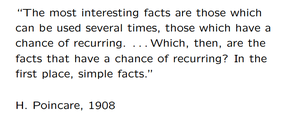A recent article with a reference to the three-body problem and its relation to predictability is an example of how popular science misconceptions find their way into finance and investments.
Note that this article is by no means an ad hominem attack against the author of the article making references to the three-body problem but the focus is only on the validity of the claims made.
The following is a quote from that article:
In 1887, Henri Poincaré proved that the motion of the three objects, except in a few special starting cases, is non-repeating. This is a chaotic system, meaning that the historical pattern of object positions has ZERO predictive power in figuring out where these objects will be in the future. There is no algorithm that a human can discover to solve this problem. It does not exist.
There are several false claims in the quoted text above.
The term chaos is a misnomer, to start with. It is often used to describe a lack of order and how deterministic systems with predictable behavior “tend” to become unpredictable and appear random when predictions are impossible to make. Usually, this is the result of sensitivity to initial conditions but not always.
Note that in the case of continuous dynamical systems, such as the three-body problem, chaos is a condition of spontaneous breaking of topological supersymmetry that is an inherent property of all mathematical models based on differential equations and applies to both deterministic and stochastic systems.
More importantly, many in popular science confuse deterministic chaos with stochastic behavior. The three-body problem is a deterministic system with nonperiodic orbits for a class of initial conditions. It is not a stochastic system, at least we hope so.
I identified at least three false claims in the above quote from the mentioned article.
False claim No 1:
…Henri Poincaré proved that the motion of the three objects, except in a few special starting cases, is non-repeating
The above does not mean that necessarily the physical three-body system is chaotic. What Henri Poincaré showed is that there can be orbits that are nonperiodic where the motions of the three bodies do not repeat but result in chaotic motion.
More importantly, Henri Poincaré proved a result for a model of the three-body based on Newtonian gravitation. Today we know that this model is very limited and although accurate under specific conditions it is only a tool and far from a law of physical reality. This model has been replaced by a more accurate model for a wide variety of conditions known as general relativity theory, which was discovered by A. Einstein. Other models are as accurate but they make some different assumptions about physical reality.
Physics has a problem of underdetermination of theories by data and observations. There can be many theories that make the same accurate predictions. Newtonian gravitation was a specific theory based on specific assumptions about physical reality that applied only under special conditions. It is impossible to elaborate on these here.
False claim No 2:
This is a chaotic system, meaning that the historical pattern of object positions has ZERO predictive power in figuring out where these objects will be in the future.
The above is a false statement. There is a time scale parameter that estimates for how long the future evolution of a (deterministic) chaotic system can be predicted known as the Lyapunov time. In the case of chaotic electronic systems, this time may be in the order of one millisecond. But in the case of the solar system, it is in the order of 5-50 million years!
For all practical purposes then, the above means that one can create a planetary ephemeris for a very long period that shows where planets were in the past and where they will be in the future. For example, NASA has predictions of solar eclipses for about 5,000 years into the future. There are also predictions of lunar eclipses for one million years into the future so the model works well and chaotic behavior does not cause problems for these periods unless there is a major change in dynamics.
False claim No. 3:
There is no algorithm that a human can discover to solve this problem. It does not exist.
NASA, academics, and even amateur astronomers have proven the above claim to be false for periods in the future in the order of thousands or even millions of years.
The above three false claims from the original quote above were used as supporting premises for a false conclusion:
[It is] impossible to identify predictive/derivative patterns
But Henri Poincaré, who as claimed in the quoted article was the one who proved that the three-body problem is chaotic, has also said this:
Then, the quoted article becomes even more ambiguous:
If you can do the calculation quickly enough, you can compute where all three objects will be one second from now. And one second from then. And one second from then. And so on and so on. With enough processing power (and this can require a LOT of processing power) you can calculate where the three objects will be 100 years from now, even though it is impossible to solve this outcome.
The above is confusing because solutions to the three-body problem exist for thousands of years into the future. Remember that the Lyapunov time is in the order of millions of years and NASA has calculated solar and lunar eclipses for at least 4,000 years into the future. This is solving the problem numerically. Trajectories of non-linear dynamical systems are found in the discrete-time domain using a variety of integration algorithms. In the past, I have even used the simpler Backward Euler to solve a very complicated problem dealing with fast modes in the concentration of ozone in the atmosphere. This is solving for the outcome, it is not an outcome from not being able to solve for the outcome. If the system is chaotic, then at some point the numerical solutions will indicate that.
After the above confusing statement, the last stage of the strawman argument appears in the article:
But this examination of the past through naïve induction will never give you The Answer. Because The Answer does not exist in the past. The Answer — which is another word for the algorithm, which is another word for “general closed-end solution” — doesn’t exist at all in a chaotic Three-Body System.
No one in the investment business is looking for the Answer (with capital A.) No one is looking for a closed-end solution. Quants look for price anomalies that, as Henri Poincaré said, “have a chance of recurring” and are simple facts, not general answers, not closed-end solutions. This is why the past is important because it can be used to:
- determine how unique hypotheses about anomalies have performed in the past and how robust they have been in a statistical sense
- Identify hypotheses (data-mining) that can serve as potential robust price anomalies after passing suitable validations tests
Both of the above approaches have been proven profitable for those with proper skills that know what they are doing. There are recent signs of increased frustration by people who have discovered quant trading in the last few years and have failed to come up with anything useful. But quant trading started in the 1990s. The learning curve is steep and it takes a long time, proper skills, and devotion to figure out what works and what does not.
No one is looking for the general solution or the Answer. Even over-fitted systems have worked well in the past for decades and made significant profits. See this paper for details and examples. The problem is not so much that market returns are not predictable but that
- many traders listen to what failed traders have to say
- complaining about markets and refuting forecasting is easier than doing the work
- developing robust strategies is a difficult and time-consuming task
- most look for solutions in the public domain instead of doing their work
Finally, apart from the false arguments based on the three-body problem and its relation to forecasting/predictions, the quoted article had some good points about fixed income and negative yields.
If you found this article interesting, I invite you to follow this blog via any of these methods: RSS or Email, or follow us on Twitter
If you have any questions or comments, happy to connect on Twitter: @mikeharrisNY







